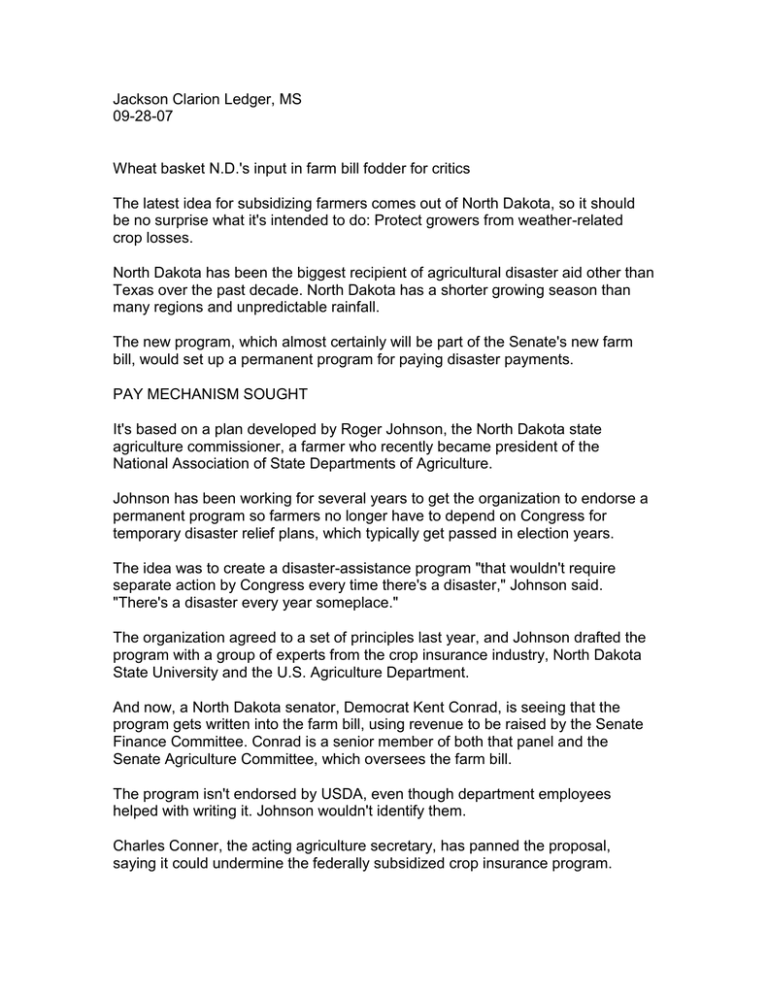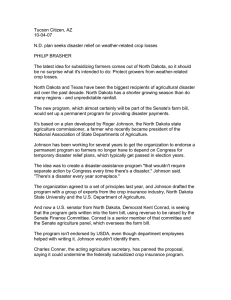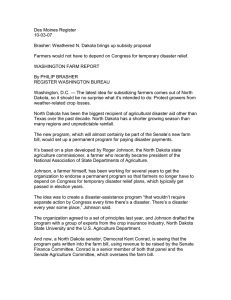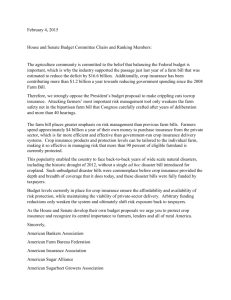Jackson Clarion Ledger, MS 09-28-07
advertisement

Jackson Clarion Ledger, MS 09-28-07 Wheat basket N.D.'s input in farm bill fodder for critics The latest idea for subsidizing farmers comes out of North Dakota, so it should be no surprise what it's intended to do: Protect growers from weather-related crop losses. North Dakota has been the biggest recipient of agricultural disaster aid other than Texas over the past decade. North Dakota has a shorter growing season than many regions and unpredictable rainfall. The new program, which almost certainly will be part of the Senate's new farm bill, would set up a permanent program for paying disaster payments. PAY MECHANISM SOUGHT It's based on a plan developed by Roger Johnson, the North Dakota state agriculture commissioner, a farmer who recently became president of the National Association of State Departments of Agriculture. Johnson has been working for several years to get the organization to endorse a permanent program so farmers no longer have to depend on Congress for temporary disaster relief plans, which typically get passed in election years. The idea was to create a disaster-assistance program "that wouldn't require separate action by Congress every time there's a disaster," Johnson said. "There's a disaster every year someplace." The organization agreed to a set of principles last year, and Johnson drafted the program with a group of experts from the crop insurance industry, North Dakota State University and the U.S. Agriculture Department. And now, a North Dakota senator, Democrat Kent Conrad, is seeing that the program gets written into the farm bill, using revenue to be raised by the Senate Finance Committee. Conrad is a senior member of both that panel and the Senate Agriculture Committee, which oversees the farm bill. The program isn't endorsed by USDA, even though department employees helped with writing it. Johnson wouldn't identify them. Charles Conner, the acting agriculture secretary, has panned the proposal, saying it could undermine the federally subsidized crop insurance program. "The message to the producers is, 'Don't insure, because we have set up a mechanism to literally pay you every year for disaster losses,"' Conner said in a conference call with reporters. "He is dead wrong," Johnson said in response. He argues that the program will actually encourage farmers to buy insurance. THEN THERE'S INSURANCE To be eligible for disaster payments, a farmer would be required to carry crop insurance on crops where the coverage is available, and the size of the potential disaster payments would be tied to the level of insurance coverage the farmer buys. The higher the insurance coverage, the larger the disaster payment would be. This feature kept crop insurance companies from opposing the program and secured the support of the Senate Finance Committee's top Republican, Sen. Charles Grassley, R-Iowa. Iowa is home to several insurance companies. Another key feature of the program is that disaster payments would no longer be tied to losses of an individual crop but instead to drops in a farm's total projected revenue, which would figure in commodity prices as well as production. So, if a farm suffers a loss in one crop, say corn, but the soybeans did OK, the grower may not qualify for a disaster payment. The farm is even less likely to qualify if it has income from hogs or other livestock. WEIGHING TOTAL COSTS Pegging disaster payments to whole farm revenue could be especially beneficial to states like, you guessed it, North Dakota, the nation's No. 2 wheat producer. When wheat yields are down, other crops are probably poor, too, said Chad Hart, an economist at Iowa State University. Johnson said the whole-farm approach will be better targeted to help farmers who really need assistance. But that doesn't mean there won't be pleas in the future for disaster relief. The Senate Finance Committee is looking at spending $1 billion on Johnson's program, about one-third of what the government paid out in disaster assistance in 2003 and 2005. Conner said $1 billion a year "at best would be a small down payment." Maybe so, but North Dakota at least is prepared to take it.






